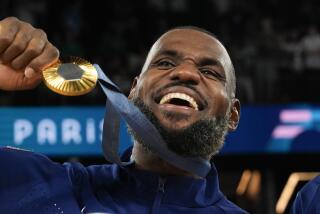WINTER OLYMPICS : Luge : U.S. Team Comes Unglued Despite New Tape
- Share via
CALGARY, Canada — “Riblet.”
What is it? The sound made by a cold frog?
Of course not. It is the secret weapon the U.S. luge team pulled out of the lab and used for the first time in competition at the Winter Olympics.
The U.S. team had big hopes for Riblet, a tape applied to the underside of the pod on the sled designed to reduce wind drag. They thought it might be so popular that one of the U.S. sliders could place in the top 10.
But the tape didn’t hold the U.S. medal hopes together very well. On medal day Monday, it was a blank tape.
While American Duncan Kennedy blamed the tape for a disappointing performance, teammate Frank Masley had the highest U.S. finish. He was 12th.
Instead of a top 10 finish, the U.S. gave itself another dose of what is becoming the common denominator for American teams at these games--controversy.
Following the lead of Willie Gault and the bobsledders, the continuing threats of litigation by the U. S. speed skaters (who have been dubbed Team Lawsuit), it was the luge team’s turn to lob a few snowballs at each other.
Kennedy was convinced that the U.S. Luge Assn. tampered with his sled and messed it up by using the tape. Kennedy finished 14th, far behind gold medalist Jens Mueller of East Germany.
U.S. team manager Mary Ellen Fletcher said Kennedy can’t make his charges stick.
“He’s 20 years old,” she said. “I think he should put the blame on himself and not anything else.”
Fletcher also said that Kennedy’s criticism of the tape, the sled and the luge association had nothing to do with how the U.S. men’s team finished.
“We don’t blame what happened to the team on his mouth,” Fletcher said.
Masley, 27, missed a top 10 finish by three-tenths of a second. He thought he was hurt much more by a poor fourth race than the tape on his sled.
“If anything, it doesn’t hurt,” Masley said. “It’s more of a mental thing than anything. But when they’re changing a sled a couple of days before a race, things got out of control a little bit.”
The tape was put on the men’s sleds Thursday. The women’s sleds were taped Friday. One of the luge team’s sponsors, 3M Corp., produced Riblet. Designer Frank Marentic of 3M believes the tape can reduce drag by as much as 8% and he stood behind his product in spite of the criticism.
“I think it’s a little bit of an attitude problem,” Marentic said. “If they don’t want it, we certainly don’t force it on them. If anything, this (tape) is helping slightly.”
Marentic said no other country’s luge team had expressed interest in learning about the tape and he thought he knew why.
“We didn’t do all that well,” he said. “If our sleds were running 1-2-3, I’m sure they’d all be looking.”
Fletcher said if the tape made the U.S. sleds faster by 100th or 1,000th of a second, it would be a success. But the U.S. sleds weren’t all that fast in the two days of the men’s luge event. Johnathan Owen, the third American slider after Masley and Kennedy, finished 23rd.
Mueller led after each of the four races. The 22-year-old sergeant in the National People’s Army was competing in his first Olympics.
Mueller, called “Little Fox” by his coaches, is 5-feet 9-inches tall and weighs 170 pounds, which is kind of big for a fox, but just about right for a slider.
The 1984 world junior champion, Mueller placed third in the 1985 world championships, second in Europe in 1986 and second in the world championships in 1987.
West German George Hackl won the silver medal and Iouri Khartchenko took the bronze. Pre-race gold medal favorite, Markus Prock of Austria, finished a surprising 11th.
Fletcher was neither surprised nor displeased by the performance of the men’s team.
“I’m absolutely thrilled,” she said. “We’re making the jump. We’re looking at the long-term plan and in the long-term plan, this is just one stop.”
Fletcher said the U.S. is looking ahead to the 1992 Olympics in Albertville, France, where the American men now sliding on the junior team could make that jump that everyone expects into the top 10, or maybe higher.
“We have a very, very powerful junior team,” Fletcher said.
The U.S. junior men’s doubles team of Jason Mulley, 17, and Lance Kirley, 16, finished second in a recent event in Italy. Tim Wiley, 19, may be one of the part of the U.S. world team next year and he is a top American prospect in singles in 1992.
There will be no sliding for Masley, who began luge training in 1977. Masley was bothered by wind which blew across the track and he didn’t get a good start, which didn’t make him happy.
“I blew it,” he said. “I’m a little bugged. I’d have liked to have made my last race a better one.”
Masley officially retired from luge after his last race Monday.
What does a retired luger do?
“Make a little money, I guess,” said Masley, a mechanical engineering student at Drexel University in Philadelphia.
Masley plans to design a sled as his senior project. He said he won’t put any tape on the bottom either.
More to Read
Go beyond the scoreboard
Get the latest on L.A.'s teams in the daily Sports Report newsletter.
You may occasionally receive promotional content from the Los Angeles Times.






